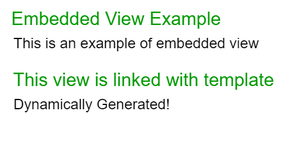AngularJS中视图和模板Url的区别
在这篇文章中,我们将看到什么是AngularJS中的Views和TemplateUrl,同时通过代码片段了解它们的基本用法,最后看到它们之间的一些区别。
视图是用户在屏幕上看到的任何东西,用于设置多个视图或手动瞄准视图。Angular使用视图来与平台连接。在Angular中,每个元素都有一个与该元素对应的视图。
视图的类型:不同类型的视图描述如下。
1.视图容器:视图容器持有主机以及嵌入式视图。而这些通常被称为视图。每个@Component类都会向Angular注册一个视图容器。视图容器的另一种引用是ViewContainerRef,它表示一个或多个视图可以被连接的容器。
例子:这个例子解释了AngularJS中视图容器的基本用途。
@Component({
selector: "sample",
template:
`<h2>View Container</h2>
<ng-container #vc></ng-container>
This is an example of view container</p>`,
})
export class SampleComponent implements AfterViewInit {
@ViewChild("vc", { read: ViewContainerRef }) vc: ViewContainerRef;
ngAfterViewInit(): void {
// outputs `template bindings={}`
console.log(this.vc.element.nativeElement.textContent);
}
}
输出:

2.Host视图:这种类型的视图承载着动态组件。主机视图是由Angular编译器为每个在bootstrap或entryComponent模块中指定的组件生成的。现在每个宿主视图负责在调用factory.createComponent时生成一个组件视图。主机视图与DOM元素相连。
例子:在这个例子中,为了使任何主机视图发挥作用,必须存在一个容纳视图的视图容器。我们这里有两个视图容器<app-example> 和<ng-container> 。
import { Component } from "@angular/core";
@Component({
template: `
<h1>Host View</h1>
<h3>Dynamically Generated!</h3>
`,
})
export class AnotherComponent {}
import { AfterViewInit, Component, ViewChild,
ViewContainerRef,
ComponentFactoryResolver } from "@angular/core";
import { AnotherComponent } from "./another.component";
@Component({
selector: "app-example",
template: `
<h1>Application Content</h1>
<ng-container #container></ng-container>
<h3>Application using host views</h3>`,
entryComponents: [AnotherComponent],
})
export class ExampleComponent implements AfterViewInit {
@ViewChild("container", { read: ViewContainerRef }) ctr: ViewContainerRef;
constructor(private resolve: ComponentFactoryResolver) {}
ngAfterViewInit() {
const factory = this.resolve.resolveComponentFactory(AnotherComponent);
this.ctr.createComponent(factory);
}
}
输出:

3.嵌入式视图:这些类型的视图与其他视图连接,没有增加输入。基本上,这些视图是为ng-template中指定的视图节点创建的。与主视图不同的是,嵌入式视图附加到其他视图。
嵌入视图和宿主视图的主要区别是,嵌入视图特别与模板相联系,而宿主视图则与组件相联系。
例子:这个例子解释了AngularJS中嵌入式视图的基本使用。
import { Component, AfterViewInit, ViewChild,
ViewContainerRef,
TemplateRef } from "@angular/core";
@Component({
selector: "app-example",
template: `
<h1>Embedded View Example</h1>
<ng-container #container></ng-container>
<!-- embed view here -->
<h3>This is an example of embedded view</h3>
<ng-template #template>
<h1>This view is linked with template</h1>
<h3>Dynamically Generated!</h3>
</ng-template>`,
})
export class ExampleComponent implements AfterViewInit {
@ViewChild("template", { read: TemplateRef }) tpl: TemplateRef<any>;
@ViewChild("container", { read: ViewContainerRef }) ctr: ViewContainerRef;
constructor() {}
ngAfterViewInit() {
const view = this.tpl.createEmbeddedView(null);
this.ctr.insert(view);
}
}
输出:

TemplateUrl:它是Angular组件装饰器中的一个属性。外部模板使用templateUrl属性来访问定义在单独位置的HTML文件,而templateUrl则负责获取该文件的路径。让我们通过一个例子来了解模板Url。
例子:这个例子解释了AngularJS中TemplateUrl的基本使用。
app.component.ts:
@Component({
selector: "email-list",
templateUrl: "./email-list.component.html",
providers: [EmailService],
})
export class EmailListComponent implements OnInit {
title = "app";
}
app.component.html:
<!DOCTYPE html>
<html>
<body>
<h2>Email List File</h2>
<p>
This is a HTML file used by external
template and is accessed using
templateUrl property
</body>
</html>
输出:

]区别:
| Views | TemplateUrl |
|---|---|
| 用户在屏幕上看到的任何东西。 | 一个由外部模板使用的属性。 |
| 用于创建单页应用程序。 | 用于获取外部HTML文件的路径。 |
| 用来设置多个视图。 | 不设置多视图。 |
| 它不接受文件引用。 | 它需要文件引用。 |
 极客教程
极客教程